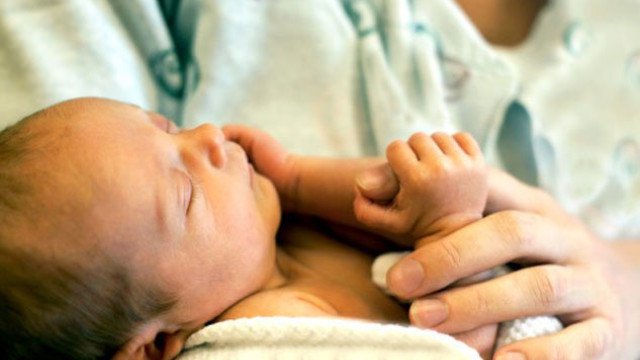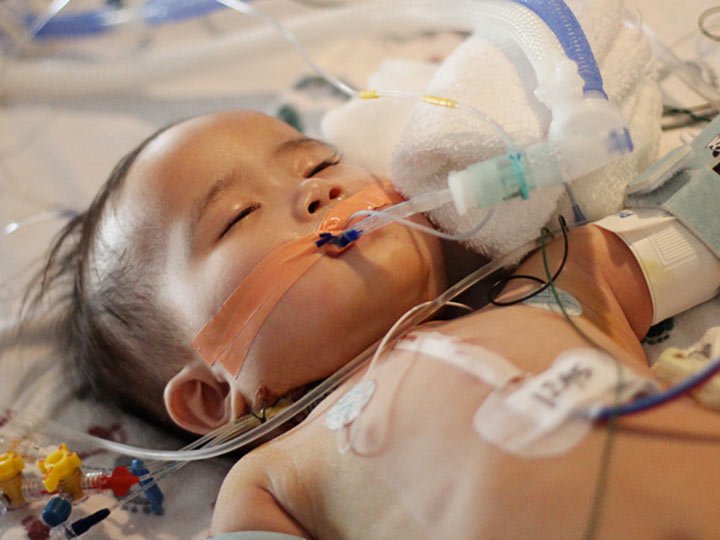Resuscitation in asphyxiated neonates
Neonatal asphyxia, if not diagnosed and treated promptly, can be life-threatening or leave serious sequelae. Therefore, neonatal resuscitation plays a very important role.
1. Definition of infant asphyxia
Newborn asphyxiation is a condition in which a baby is born without breathing or crying, causing lack of oxygen and excess CO2 in tissues. If prolonged, it will cause sequelae or death.
According to WHO, approximately 1 million child deaths each year are related to asphyxiation. Approximately 10% of neonates require assistance to initiate initial breathing, 1% require life-saving resuscitation, and 90% can self-complete to neonatal circulation and spontaneous breathing.
Evaluation of risk factors for asphyxia in neonates .
Prenatal factors The nature of the amniotic fluid is clear or green and mixed with meconium: There is excretion of meconium into the amniotic cavity. With certainty of acute fetal distress: Abnormalities of fetal heart rate. Using some inhibitors for the mother: analgesics, psychotropic drugs, anesthetics, Beta-blockers. Over a 4-hour period there is a risk of respiratory failure for the infant. Bleeding in labor: Placenta praevia. Asphyxia in labor: high-risk labor for the newborn: Preterm or premature delivery, multiple births, maternal and fetal infections (fever, dirty amniotic fluid, premature rupture of membranes, urinary tract infections of the mother), difficult delivery due to mechanical (pelvic disproportion, abnormal fetal position). Prolonged labor, prolonged delivery time, umbilical cord pathology (short umbilical cord, placenta entrapment, placental prolapse, umbilical cord knotted, umbilical cord rupture), delivery method (cesarean section, forceps) Steps of resuscitation A, B, C include: ensuring airway ventilation, ensuring breathing, ensuring circulation and ensuring the child is warm...
2. Assess infant asphyxiation
Index APGAR
| Dấu hiệu | 2 | 1 | 0 |
| Hô hấp | Khóc to, thở bình thường | Khóc yếu, rên | Không thở |
| Tim | ≥ 100 lần/phút | < 100 lần/phút | Không có |
| Màu da | Hồng | Tím | Tái nhợt |
| Trương lực | Tốt | Yếu | Nhẽo |
| Phản xạ | Cử động tốt | Nhăn mặt | Không |
Rating:
8-10 points: normal, 6-7 points: mild asphyxiation, 4-5 points: severe asphyxia, ≤ 3 points: very severe asphyxia.
Evaluation time: 1, 5, 10 minutes.
Three signs to decide on resuscitation that are respiration, heart rate, skin color are also part of the scale, two parts (muscle tone, reflexes) reflect neurological status.

Trẻ sơ sinh bị ngạt không được chẩn đoán và điều trị kịp thời sẽ bị di chứng hoặc tử vong
3. Neonatal resuscitation steps
Follow principles A, B, C, D.
Principle A: open airways
Clear amniotic fluid:
A healthy baby wipes dry, keeps warm, corrects airway position. Unwell child: clean the mouth and nose; No more than 5cm in the mouth, no more than 3cm in the nose Amniotic fluid contains meconium:
Healthy children: suck the meconium out of the mouth, nose, dry, keep warm, correct the position of the airway.. Unwell children: use a large 12F catheter clean the mouth, throat, and nose of the child. Use a laryngoscope to clearly see the glottis and aspirate it, then intubate the larynx with suction and withdraw. Principle B: provide respiratory support
Oxygen supply: Free flow oxygen 5 times/minute suction
Indication: when the child breathes okay but purple center. Oxygen delivery methods: oxygen mask, cupping oxygen wire like a mask CPR (positive pressure ventilation)
Indications:
Free-flow oxygen after 30 seconds the baby is still purple. Stop breathing or hiccups. Heart rate < 100 beats/min even when the child is breathing on his own Technique: Ensure 4 standards
Put on a mask that covers the nose and mouth. Squeeze the ball frequency 40-60 times/minute (make sure the frequency we count mentally: Breathe - Two - Three - Breathe - Two - Three...) Moderate pressure use 2-3 fingers without squeezing the whole table hand. Maintain a straight airway at all times. Assess response to ventilation
After each chest compression is effective. Improve the child's heart rate, breathing rate, skin color If the chest does not inflate on ventilation immediately check:
Clear airway, reposition the child's head Reposition the mask to fit the child's face Ball Is there a perforation? Intubation ventilation
Indications:
Amniotic fluid with meconium unwell child intubated then both suction and extubated. Balloon compression does not improve, respiratory arrest requires prolonged ventilation. Need to combine chest compressions. Intubation for drug administration Diaphragmatic hernia. The size of the endotracheal tube is according to the weight of the child but has different sizes
The depth of the endotracheal tube is equal to the child's weight (P- kg) + 6 cm.
Principle C: circulatory support
Indication: When heart rate is < 60 beats/min despite 30 seconds of effective positive-pressure ventilation (ie, after 30 seconds of mask ventilation or intubation with oxygen) 100%)
Technique of chest compression: ensure requirements:
Position: press 1/3 below the sternum, or below the nipple line 1 stroke of the child's finger. Frequency: 120 – 140 times/minute in combination with ball squeeze according to the ratio of ball squeeze/chest compression = 1/3. Compress about 1/3 of the anteroposterior diameter of the infant's ribcage. Press perpendicularly with the thumb technique, hands do not leave the position of pressing the heart on the chest.

Đặt nội khí quản thông khí là một trong các nguyên tắc hồi sức sơ sinh
Principle D: emergency medicine (Epinephrine 1/1000)
Indication: Heart rate <60 beats/min despite positive pressure ventilation in combination with correct and effective chest compressions.
Dose: dilute concentration 1/10,000
Endotracheal pump: 0.3ml - 1ml. Intravenous route: 0.1ml - 0.3ml If not weighed in time: 1.5ml/time through endotracheal tube, 0.5ml/time IV injection.
During and after the adrenaline injection, continue to coordinate balloon and chest compressions.
Other effective care:
Pay attention not to do the following movements:
Fold your thighs into the child's abdomen. Turn the baby's head upside down and pat the bottom, shaking the baby. Poke the child's anus. At Vinmec International General Hospital, pregnant women can experience "painless delivery" with a team of highly experienced doctors and nurses, and the delivery room is designed according to modern, friendly, and well-equipped standards. facilities and equipment to ensure safety for pregnant women. In particular, at Vinmec Hospital, there is an ultrasound machine in the delivery room that can measure the position of the fetus's head in the mother's pelvis, helping to predict a difficult or easy delivery for the doctor to choose an appropriate and safe delivery method. All for mother and child. Each delivery room has the most modern neonatal care car, full of equipment from warm lights, baby scales, baby's health assessment system (measures heart rate, breathing rate, blood pressure, blood oxygen). )... helps in timely diagnosis and treatment of health problems of children at birth.
Để đặt lịch khám tại viện, Quý khách vui lòng bấm số HOTLINE hoặc đặt lịch trực tiếp TẠI ĐÂY. Tải và đặt lịch khám tự động trên ứng dụng MyVinmec để quản lý, theo dõi lịch và đặt hẹn mọi lúc mọi nơi ngay trên ứng dụng.






